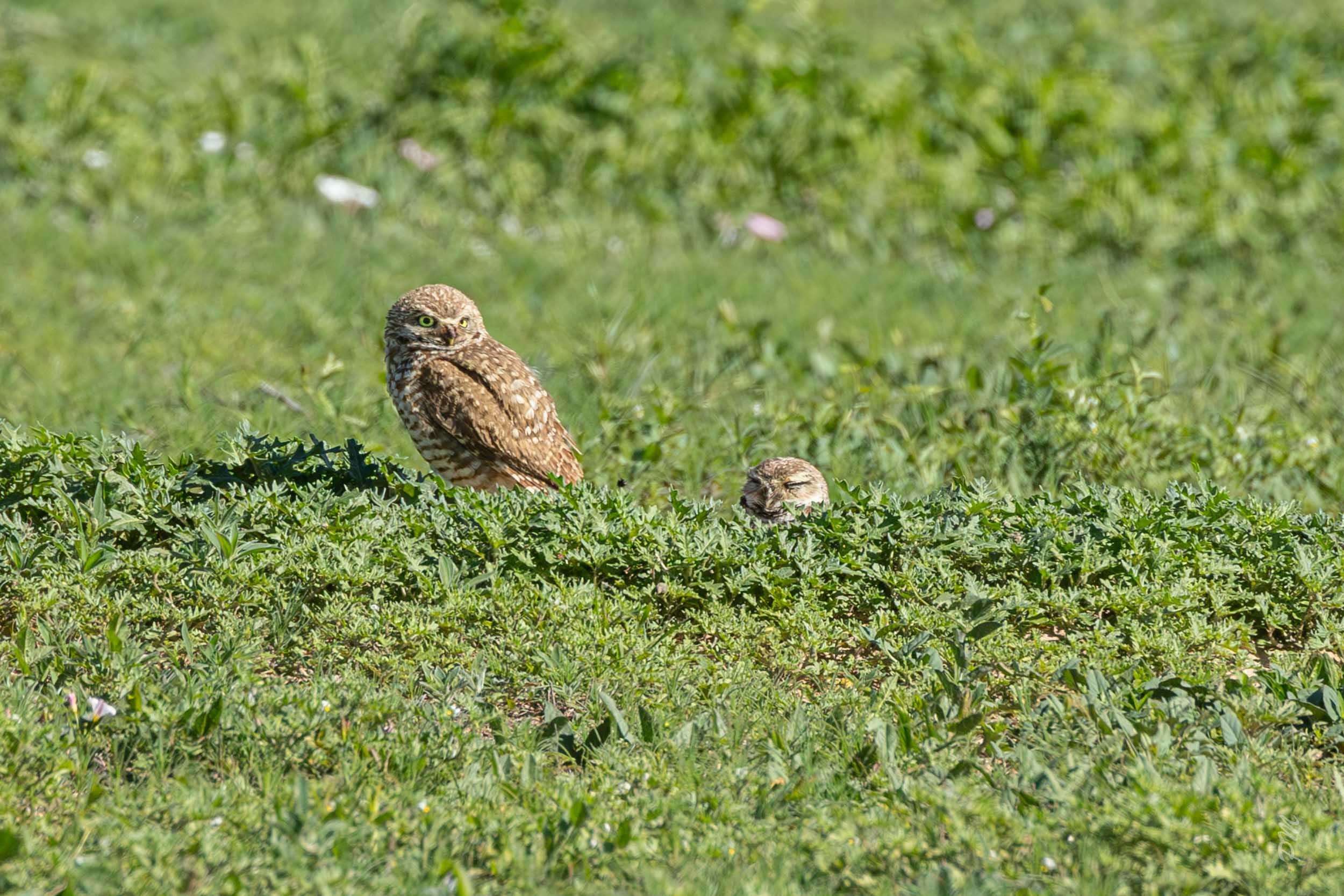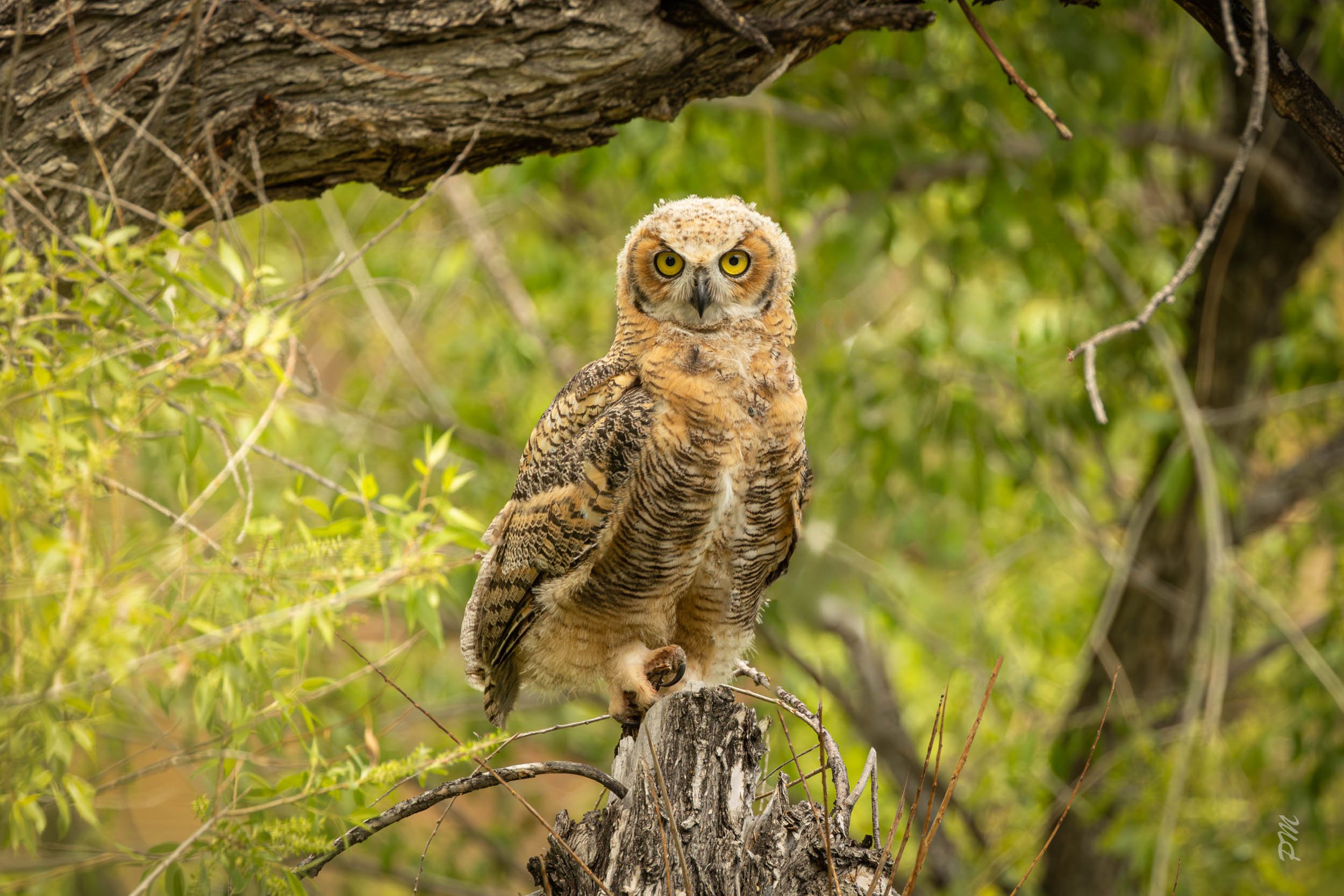Is an Owl’s Nest a “Real” Nest?
The last couple of years I’ve become fascinated – make that obsessed – with owl “nests”. OK, but why the quotation marks around nests, you ask? Isn’t an owl nest a “real” nest (there’s those pesky marks again!)? Yes. Yes, they are, but they are very unique within the bird kingdom.
Simply put, owls don’t build nests like most other birds do. They steal borrow – ahem, appropriate - “pre-owned” nests, particularly those of hawks. Or they get creative by finding a comfortable nook of a large tree trunk or a building or a viaduct to nest in. In the case of Burrowing Owls, they more often than not use a prairie dog hole.
Photo above - This female Great-Horned Owl found the intersection of several tree trunks perfect for her nest.
Photo above - Burrowing Owl on the right stands in a hole previously dug by a Prairie Dog as its partner watches on.
The male owl of a nesting pair usually finds the general territory to nest in early in the year, but the female finds the specific nesting site in later winter/early spring. There she literally lays low in the nest until the eggs start hatching. You can usually only see the top of her head during that time if the nest is high up.
To customize their new digs, owls like to “decorate” the inside of their nests using sticks, feathers and other items from nature or even man. Before you consider hiring an owl to give you creative interior decorating advice, I should warn you that in the case of Burrowing Owls they often fill their nest cavities with coyote scat. Yeah, so much for that idea, right?
Photo above - Burrowing Owl brings a stick to its nest to “decorate” the nest.
This Spring I had the incredible rare good fortune to find a nest that had TWO female Great Horned Owls sitting in it during and after the eggs hatched. Very little is known about this phenomenon, and I could only find one other recorded instance of this happening in the U.S. Male owls do not sit in the nest and in this case the male was observed nearby and then hunting for the nest. This particular nest was very high up and obscured by other trees, but I managed to get a halfway decent shot as shown below.
Photo above - Rare scene of TWO female Great Horned Owls in a nest likely “co-mothering” the chicks. Look closely in between the two and you’ll see the beak of one of the owlets.
As the eggs hatch, the female begins to sit more upright and become more visible. And then the babies, called chicks or owlets, also begin to appear. Mom typically lays 2-3 eggs. Sadly, not all will make it although my experience has been quite positive with viewing a clutch of three eggs that seems to make it to the fledging stage a couple months later.
Owlets are little “fuzzballs” after hatching that remind people variously of either Brillo pads or to me a Hostess coconut flake Snowball snack! Remember those?
Photo above - Notice how white the feathers are on these baby Great Horned Owls?
Owlets grow up quickly. Within a month their feathers change from that fuzzy white to mostly a fully colored and feathered adult.
By now, the nest is crowded – like, really crowded. Solution? Mom parks herself on a nearby branch where she cedes the nest to the babies and gets the added benefit of not only some space as well as peace and quiet. Sometimes Dad, who is always nearby providing hunted food to his family, joins Mom to catch a few winks together while they can.
Photo above - Mom and Dad Great-Horned Owl catch a few winks near the nest where their new brood is living.
Once Mom heads out of the nest, soon the babies follow by “branching out” (literally and figuratively) as they take their first steps, venturing out only a few feet first and then back into the nest.
Photo above - These two young sibling Great Horned Owls have walked out on to a branch near the nest as they begin to experience the world.
This is the equivalent of a toddler crawling, which means walking is next – or, in the case of birds, flying. Those flights are short and never venture far from home. Siblings often stay close to each other, and the parents are rarely far away, too.
Photo above - This beautiful owlet had just taken a short flight from its nest to a nearby tree. Notice how colorful its feathers are and its size so soon after hatching a couple months earlier. (hat-tip to shooting partner Shelley for spotting this!)
But soon enough it’s time to “spread their wings” (wow, what literary metaphors I can use!) and head out on their own. Everybody will eventually go their separate ways, only to have Mom and Dad start the process of finding that re-starter home once again next year!







